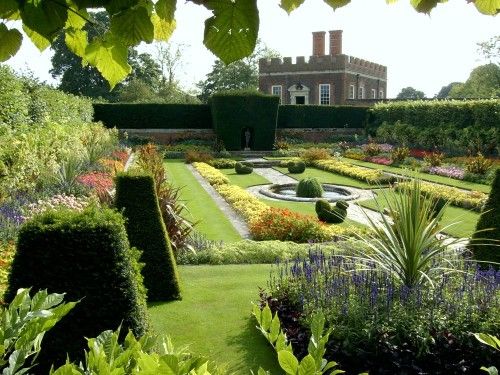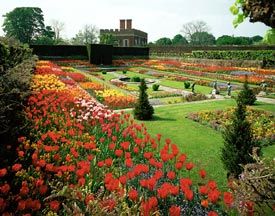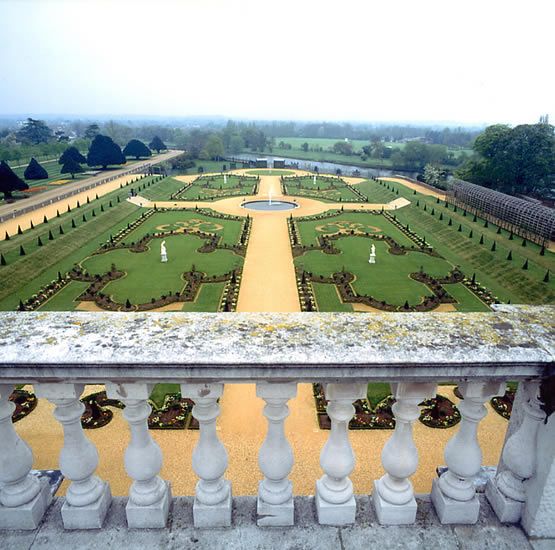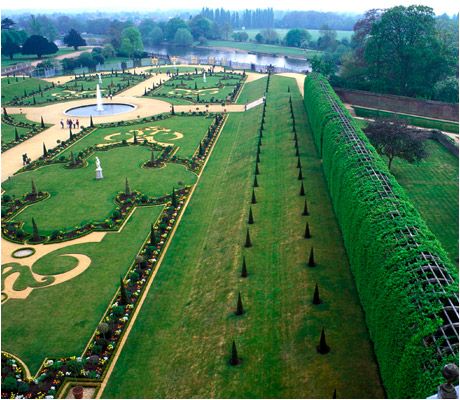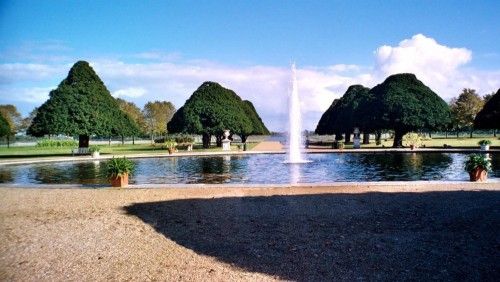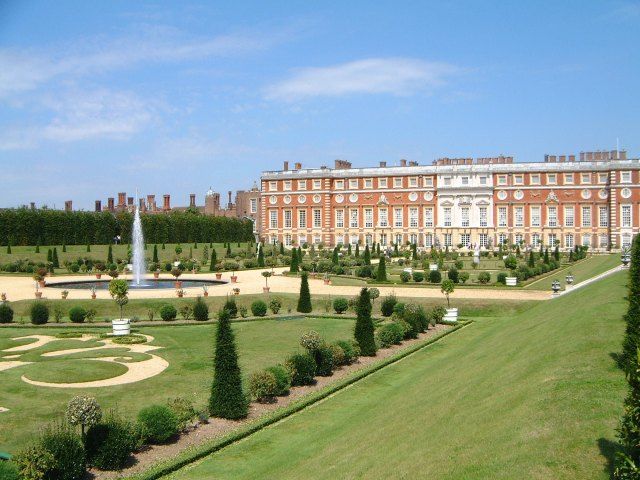Hampton Court Palace Gardens
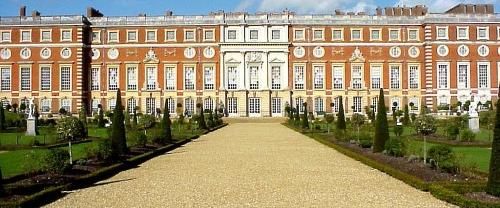
The Hampton Court gardens are a subtle mix of 500 years of royal gardening history and like the palace, their history has agricultural origins. The lands surrounding the earliest buildings at Hampton Court were farmed by the Knights Hospitallers (the earliest owners of the site) to raise funds for their military activities in the Holy Land. Sir Giles Daubeney, Henry VII's Lord Chamberlain, who took a 99-year lease on the property in 1505, was the first to enclose 300 acres of plough land as a deer park. The present Home Park was also probably made into a deer park, with rabbit warrens, for his entertainment.
It was Cardinal Wolsey (c1475-1530) who created the earliest garden at Hampton Court, probably on the site of the present Fountain Court. But it was Henry VIII (1509-47) who, in 1529, began to establish the structure of the gardens, very much as they remain today. His layout survived, despite changes in horticultural fashion and garden design, until the reign of William III (1689-1702) and Mary II (1689-94) when they decided to re-plan the whole of the estate in the Baroque manner.
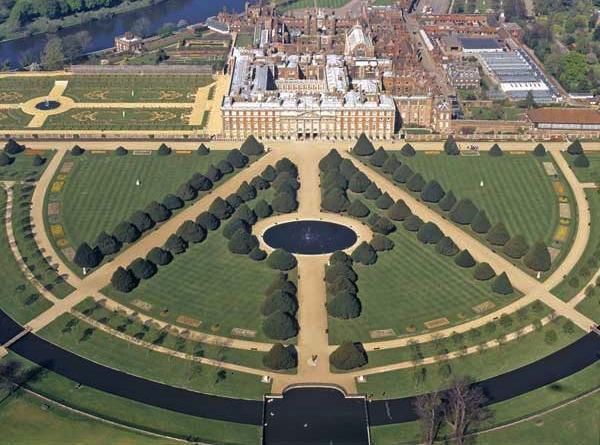
THE SOUTH GARDENS
The gardens to the south of the palace have always been the private gardens, which have provided the palace with produce.
|
|
|
The Privy Garden
The Privy Garden, the king's private garden, has recently been restored to the way it appeared when it was completed for William III in 1702, using the same varieties of plants that were originally in the garden. Separating the garden from the river is an ornamental ironwork screen by the French blacksmith, Jean Tijou, which is currently being restored.
Knot Garden
To the west of the Privy Garden is a small Knot Garden made of box hedging which was planted in 1924, an early attempt to show the sort of gardens that might have been at Hampton Court in the 16th century.
|
|
|
Pond Gardens
Further west are the Pond Gardens. These three sunken gardens were originally ornamental ponds used for holding freshwater fish until they were needed in the kitchens for cooking. Today they contain impressive displays of spring and summer bedding.
Lower Orangery
The Lower Orangery was originally built to house Mary II's collection of botanical specimens. More recently it was converted into a gallery to display Andrea Mantegna's Triumphs of Caesar.
Great Vine
Close to the Lower Orangery is the Great Vine planted in 1768 by Lancelot 'Capability' Brown. It is the oldest known vine in the world and still produces 500-700lbs (230-320kg) of grapes each year. The grapes are harvested at the end of August and are sold in the palace shops.
Banqueting House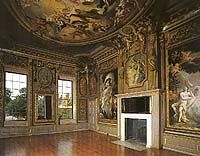 On the south side of the grdens overlooking the Thames is the Banqueting House built by William III in 1700 for small parties after dinner at the palace. The main room was decorated by Antonio Verrio, who was also responsible for most of the wall and ceiling paintings in the palace. The oval ceiling panel depicts Minerva as the Goddess of Wisdom, surrounded by allegorical figures of the arts and sciences, while the walls show the loves of Jupiter. The Banqueting House is open in summer only.
On the south side of the grdens overlooking the Thames is the Banqueting House built by William III in 1700 for small parties after dinner at the palace. The main room was decorated by Antonio Verrio, who was also responsible for most of the wall and ceiling paintings in the palace. The oval ceiling panel depicts Minerva as the Goddess of Wisdom, surrounded by allegorical figures of the arts and sciences, while the walls show the loves of Jupiter. The Banqueting House is open in summer only.
THE EAST GARDENS
In Henry VIII's time, this area was parkland but was gradually enclosed by the Stuarts and under William III was laid out as a great semicircular parterre with 12 marble fountains. Queen Anne (1702-14) added the surrounding semicircular canals in 1710.
|
|
|
The Great Fountain Garden
The Great Fountain Garden, as it is now known, has been much simplified since then and although many of the yew trees date from 1707, the overall layout is predominantly Victorian.
Home Park
Beyond the East Front gardens is Home Park with the great canal, or Long Water, dug for Charles II in the 1660s. The park contains a herd of 270 deer, a golf course founded in the 19th century and an oak tree from the original park, which is probably over 1,000 years old.
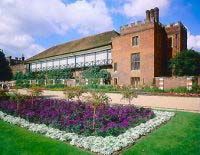
Royal Tennis Court
At the north end of the Broad Walk is the Royal Tennis Court, which can be visited. Built in the 1620s, it is still in use today and provides a venue for the British Open Real Tennis Championships.
THE NORTHERN GARDENS
In Tudor times Henry VIII's Great Orchard occupied the land to the north of the palace but during the reign of William III this entire area, known as the Wilderness, was planted out with tall clipped hedges in geometric patterns. Today these gardens are famous for their splendid carpet of spring bulbs.
The Maze
The Maze, planted in 1702, is the only remaining part of William III's Wilderness (see above). Its winding paths amount to nearly half a mile (0.8km) and cover an area of a third of an acre (about 1,350 square metres). One of Jerome K Jerome's Three Men in a Boat declared the Maze 'very simple...it's absurd to call it a maze', only to become completely lost. Inside he met other visitors 'who had given up all hope of ever seeing their home and friends again'!
Tiltyard
Close to the Maze is the Tiltyard. Originally built by Henry VIII for tournaments, it was divided up into smaller gardens in the 18th and 19th centuries. It now comprises six areas including the Rose Garden, Herbaceous Garden and the Tiltyard Tea-rooms.
Source:
www.hrp.org.uk
Articole asemănătoare
-
Laleaua Purple Lady
Un plus de culoare si eleganta pentru orice gradina, lalele din soiul Purple Lady sunt delicate, cu un colorit violet deschis, intens, sunt spre deosebire de alte lalele rezistente la frig si la perioadele geroase, perfecte atat pentru ghivece, jardiniere sau gradini cat si pentru buchete sau aranjamente florale de mari dimensiuni.
-
Gradinile Tivoli, Copenhaga
"Gradinile Tivoli” este un faimos parc de distractie din Copenhaga, deschis in anul 1843, si unul dintre cele mai importante din Europa.
-
Gradinile chinezesti, un peisaj mirific de neinlocuit
Traditionala gradina chinezeasca si-a facut aparitia in dinastia Tang si a evoluat in timp intr-o maniera frumoasa dand nastere unui design cu bazine si fantani, dealuri, urcusuri si coborasuri implementat si astazi in gradinile din intreaga lume.
-
Biblioteca Gradinarului
GRADINARITUL MODERN INTR-UN CLIMAT DE SCHIMBARE - cartea este scrisa de unul dintre cei mai renumiti gradinari din lume, Matthew Wilson.
-
Mirabell Gardens
Daca vizitati Salzburg, nu ratati ocazia sa va plimbati prin Mirabell Gardens, considerata cea mai frumoasa gradina amenajata in stil baroc din Europa...
